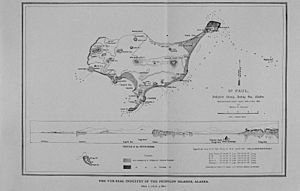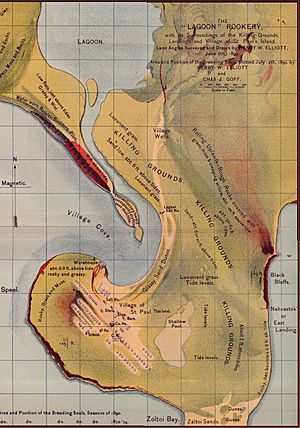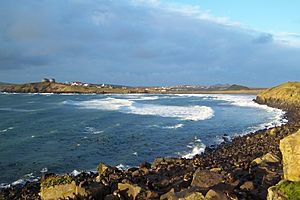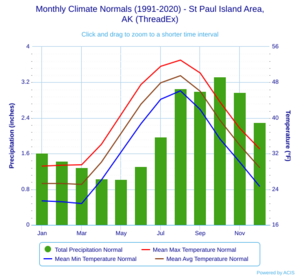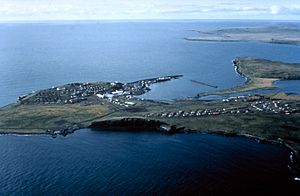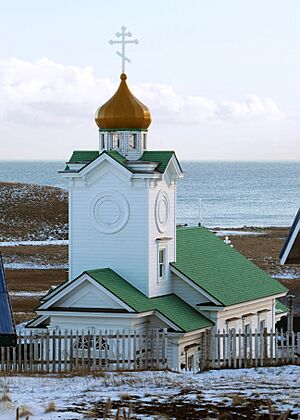St. Paul, Alaska facts for kids
Quick facts for kids
St. Paul
Tanax̂ Amix̂
|
|
|---|---|
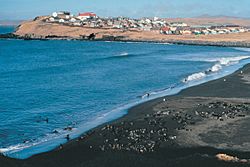
St. Paul, Alaska
|
|
| Country | United States |
| State | Alaska |
| Census Area | Aleutians West |
| Founded | 1943 |
| Incorporated | June 29, 1971 |
| Area | |
| • Total | 295.46 sq mi (765.25 km2) |
| • Land | 42.62 sq mi (110.39 km2) |
| • Water | 252.84 sq mi (654.86 km2) |
| Elevation | 23 ft (7 m) |
| Population
(2020)
|
|
| • Total | 413 |
| • Density | 9.69/sq mi (3.74/km2) |
| Time zone | UTC-9 (Alaskan (AKST)) |
| • Summer (DST) | UTC-8 (AKDT) |
| ZIP code |
99660
|
| Area code | 907 |
| FIPS code | 02-66470 |
| GNIS feature ID | 1419163 |
St. Paul is a city located in the Aleutians West Census Area, Alaska, United States. Its native Aleut name is Tanax̂ Amix̂ or Sanpuulax̂. The city is the main settlement on Saint Paul Island, which is part of the Pribilofs. This small group of islands is found in the Bering Sea. In 2020, the population of St. Paul was 413 people. Saint Paul Island is very famous for birdwatching.
The three islands closest to Saint Paul Island are Otter Island to the southwest, Saint George to the south, and Walrus Island to the east. Saint Paul Island covers about 43 square miles (110 square kilometers). In 2008, the island had one school for grades K-12 with 76 students, a post office, a small store, and a church. The Sts. Peter and Paul Church is a Russian Orthodox church listed on the U.S. National Register of Historic Places. Saint Paul Island was one of the last places where woolly mammoths lived, until about 5,600 years ago.
Contents
Geography and Island Features
St. Paul is located at 57.133806 degrees North latitude and -170.266614 degrees West longitude.
Saint Paul Island's Size and Shape
Saint Paul is the largest of the Pribilof Islands and is the farthest north. It is about 7.66 miles (12.33 km) wide at its widest point. The island is 13.5 miles (21.7 km) long on its longest side, which runs from northeast to southwest. Its total area is about 43 square miles (110 square kilometers).
Volcanic Origin and Landscape
Saint Paul Island was formed by volcanoes. It has several cinder cones and volcanic craters in its middle. The highest point is Rush Hill, which is 665 feet (203 meters) tall on the western shore. Most of the higher areas are less than 150 feet (46 meters) high. The island is mostly low-lying with rocky areas and valleys. Some valleys hold freshwater ponds. Its 45.5 miles (73.2 km) of coastline are mostly rugged and rocky, with tall cliffs. However, there are also long sandy beaches with sand dunes along some shallow bays.
Island Geology and Plants
Like the other Pribilof Islands, Saint Paul is made of basalt rock. Its hills are mostly brown or red tufa and cinder piles. Some hills are made of red scoria and breccia. The island is on the southern edge of the Bering-Chukchi platform. It might have been part of the Bering Land Bridge's southern coast during the last ice age. Studies of soil samples show that plants similar to today's tundra have grown here for at least 9,000 years. The thick, rough grass is mostly made of umbellifers (like Angelica) and Artemisia. Grasses and sedges are also common.
History and Culture of St. Paul
Early Discoveries and Russian Influence
The Aleut people knew about the Pribilof Islands long before people from the West discovered them. They called the islands Amiq, which means "land of mother's brother" or "related land" in the Aleut language. Their stories say that the son of an elder from Unimak Island found them. He was trying to survive a storm at sea. When the winds stopped, he was lost in thick fog. Then, he heard the sounds of Saint Paul's huge seal colonies.
Russian fur traders discovered the Pribilofs in 1786. The islands were named after the Russian navigator Gavriil Pribylov. No Alaska Natives are known to have lived on the island before this time. The Russians first landed on St. George on July 12, 1788. They named the larger island to the north St. Peter and St. Paul Island.
Aleut Forced Labor and Changes in Control
In the 18th century, the Russian-American Company forced Aleuts from the Aleutian chain to hunt seals for them on the Pribilof Islands. Before this, the Pribilofs were not regularly lived on. The Aleuts were forced to work for the Russians. They hunted, cleaned, and prepared fur seal skins, which the Russians sold for a lot of money. The Aleuts were not allowed to go back to their home islands. They lived in very difficult conditions and were controlled by the Russians. Their descendants live on the two islands today.
In 1870, the U.S. government gave the Alaska Commercial Company a 20-year lease to hunt seals. This company used to be the Russian-American Company. They gave housing, food, and medical care to the Aleuts in exchange for their work. By 1890, the fur seals had been hunted too much, and only about 200,000 fur seals were left. The 1910 Fur Seal Treaty stopped private seal hunting on the islands. It placed the community and fur seals under the U.S. Bureau of Fisheries. During this time, food and clothing were hard to find, and working conditions were poor. The Saints Peter and Paul Church, a Russian Orthodox church, was built on the island in 1907.
World War II and Aleut Compensation
During World War II, the Imperial Japanese Army threatened the Aleutian Islands. Because of this, 881 Aleuts from the Pribilof islands were forced to leave their homes. They had only a few hours' notice. They were sent to live in old salmon canneries and mines in Southeast Alaska until May 1944. Some Aleut men were brought back temporarily in 1943 to hunt fur seals for the government. Seal oil was used to help with the war effort. Most Aleuts from the Pribilofs were held at Funter Bay on Admiralty Island.
In 1979, the Aleut people from the Pribilof islands received $8.5 million. This was partial payment for the unfair treatment they faced from the government between 1870 and 1946. In 1983, Congress passed new laws that ended government control over commercial seal hunting. It also reduced the federal government's presence on the island. Local groups became responsible for community services and managing the fur seals. $20 million was given to help the island's economy. $12 million went to St. Paul and $8 million to St. George. Commercial seal hunting on St. Paul stopped in 1985. Now, owning fur seal pelts is not allowed, except for traditional uses.
Population and People
| Historical population | |||
|---|---|---|---|
| Census | Pop. | %± | |
| 1880 | 298 | — | |
| 1890 | 244 | −18.1% | |
| 1910 | 201 | — | |
| 1920 | 212 | 5.5% | |
| 1930 | 247 | 16.5% | |
| 1940 | 299 | 21.1% | |
| 1950 | 359 | 20.1% | |
| 1960 | 378 | 5.3% | |
| 1970 | 450 | 19.0% | |
| 1980 | 551 | 22.4% | |
| 1990 | 763 | 38.5% | |
| 2000 | 532 | −30.3% | |
| 2010 | 479 | −10.0% | |
| 2020 | 413 | −13.8% | |
| U.S. Decennial Census | |||
Saint Paul Island has the largest Aleut community in the United States. The Aleut are one of the U.S. government's officially recognized Native American groups in Alaska. Out of 480 people, 457 (86 percent) are Alaska Natives.
St. Paul first appeared in the 1880 U.S. Census as an Aleut village. In 1890, it had 244 residents. Most were mixed Russian and Native, with others being Native, white, and Asian. It became a formal city in 1971.
In 2000, there were 532 people living in the city. The average household had 2.88 people, and the average family had 3.44 people. About 29.5% of the population was under 18 years old. The median age was 32 years. The median income for a household was $50,750. About 11.9% of the population lived below the poverty line.
Nature and Wildlife on Saint Paul Island
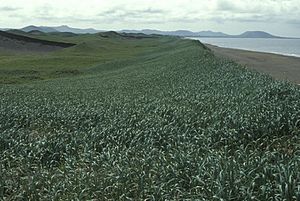
Saint Paul Island is part of the Alaska Maritime National Wildlife Refuge. Its tall cliffs, where seabirds live, were bought in 1982 to be part of the refuge. The island is also known as an Important Bird Area.
More than 500,000 northern fur seals breed here. Millions of seabirds also live on the island. The waters around the island are some of the best fishing grounds in the world.
Woolly Mammoths and Climate Change
Woolly mammoths lived on Saint Paul Island until about 5,600 years ago. This was the last known group of mammoths in North America. Scientists believe they died out because of less fresh water. Climate change made the island drier. Also, the mammoths' activity caused the few freshwater lakes on the island to erode, making them even smaller.
A large number of puffins died on St. Paul Island between October 2016 and January 2017. This was likely caused by changes in the ecosystem due to climate change. Climate change has also made the winters warm enough for rats to survive on St. Paul. So, as of 2024, the island's harbor has traps to catch any rats that might arrive on ships.
Birds of Saint Paul Island
Over 319 different kinds of birds have been seen on the island. In spring (May to mid-June) and fall (August to October), many rare birds, including those from Siberia, can be spotted. The cliffs of Saint Paul, Saint George, and Otter Island are home to many breeding seabirds. This includes important nesting areas for the red-legged kittiwake.
Many birds from the auk family live here. These include horned and tufted puffins, thick-billed and common murres, parakeet, crested and least auklets, and ancient murrelet. Other species visit or pass through. Breeding ducks include long-tailed duck, northern pintail, and green-winged teal. Shorebirds that breed here are semipalmated plover, the Pribilof type of rock sandpiper, least sandpiper, and red-necked phalarope. Few landbirds breed here, but they include types of gray-crowned rosy finch and Pacific wren, snow bunting, Lapland longspur, and sometimes hoary or common redpolls, or common raven.
Northern Fur Seals: Life Cycle and Rookeries
One of the most amazing sights on the island are the northern fur seal rookeries. The Pribilof Islands are home to about half of all the northern fur seals in the world. Some of the seal rookeries on Saint Paul Island have over 100,000 seals!
In late May, the male seals arrive and claim their areas. They get ready for the females, who usually arrive in the third week of June. The females give birth soon after they reach land. By mid-July, there are hundreds of young pups all around the island. From June 1st to mid-October, the rookeries are closed to visitors. During the summer, you can view these marine mammals from special viewing spots at two rookeries if you have a permit.
Other Marine Animals
Harbor seals breed on Otter Island, which is a few miles southwest of St. Paul Island. However, they are often seen near St. Paul's shores. Sometimes, Steller sea lions come ashore on St. Paul. They usually stay in the rookery at Walrus Island, about 10 miles (16 km) northeast of St. Paul. Very rarely, grey whales, orcas, and walrus are seen offshore.
Blue Fox
The Blue fox is a type of Arctic fox. These foxes live only on the island. They can be seen roaming the hills and climbing the cliffs, looking for food. While they can catch gulls, foxes near the town prefer to find food in garbage. They also explore the fishing docks and processing plant. Young foxes hide under storage containers and eat scraps given by fishermen. Some young foxes lose their dark fur faster than their siblings and get fluffy white/grey fur by mid-September. Foxes that live farther from human homes are more aggressive and protective of their areas. Near the fur seal rookeries, the foxes and seals live together easily.
Reindeer
A large group of reindeer lives on the island. These reindeer came from domesticated Russian animals. In the fall of 1911, 25 reindeer were brought to the island. Their numbers grew to 2,046 in 1938, but then dropped to only 8.
Wildflowers
In spring, when the island turns green, wildflowers start to bloom across the tundra landscape. There are over 100 kinds of wildflowers. These include the Arctic lupine, with its bluish-purple flowers, and the bright yellow Alaska poppy.
Climate and Weather
St. Paul has an Arctic maritime climate. This means the nearby Bering Sea keeps the weather cool all year. Temperatures usually range from 19 to 51 degrees Fahrenheit (-7 to 11 degrees Celsius). The island gets about 25 inches (64 cm) of rain each year, and about 56 inches (142 cm) of snow. Heavy fog is common in summer. Lightning and thunder are almost never heard. The last thunderstorm in St. Paul was on November 8, 1982, which was the first in 40 years.
Saint Paul's climate is strongly affected by the cold waters of the Bering Sea. It is classified as polar because of the very cold summers. The island has a small range of temperatures, strong winds, high humidity, and lots of clouds. Summer fog is also common. There is a big delay in seasons: February is the coldest month, while August is the warmest. The average low temperature in February and the average high temperature in August only differ by about 31.8 degrees Fahrenheit (17.7 degrees Celsius).
The average temperature for the year is above freezing, at 35.9 degrees Fahrenheit (2.2 degrees Celsius). However, the average monthly temperature stays below freezing from December to April. Low temperatures of 0 degrees Fahrenheit (-18 degrees Celsius) or colder happen about 4.7 nights per year, mostly from January to March. The island is in USDA Hardiness Zone 6. The coldest temperature ever recorded was -26 degrees Fahrenheit (-32 degrees Celsius) on January 27, 1919. The warmest was 66 degrees Fahrenheit (19 degrees Celsius) on August 14, 2020, and August 25, 1987. Winds are strong all year, averaging around 15 miles per hour (24 km/h). They are strongest from late autumn through winter, blowing mostly from the north. In summer, they are weaker and blow mainly from the south.
The island's humidity is high, averaging over 80 percent all year. It is highest in the summer. Cloud cover is also highest in the summer. While high all year (88 percent average), cloud cover reaches 95 percent in the summer. Fog is also more common in summer, happening about one-third of the days. The island gets about 23.8 inches (60.5 cm) of rain each year. The most rain falls between late summer and early winter, when Bering Sea storms hit the island. Snowfall is highest between December and March, averaging 61.7 inches (157 cm) per year. There is usually no snow from June to September. Strong winds and relatively warm temperatures keep snow levels low. Hours of daylight range from 6.5 hours in midwinter to 18 hours in midsummer.
Facilities and Services
Water is supplied by wells and an aquifer (underground water source) and is treated. There are two new wooden water tanks, one holding 500,000 gallons and another 300,000 gallons. All 167 homes and buildings have piped water and sewer systems. A new pipe was recently added to send seafood processing waste into the ocean. The city collects trash. A recycling program run by the local Tribe is currently on hold. A landfill, incinerator, and sites for sludge and oil disposal have been built. A new $3 million power plant started operating in 2000. A small wind turbine provides power and hot water to the village office, but it is not connected to the main power grid. Electricity is provided by St. Paul Municipal Electric Utility.
TDX Power built its first energy-generation facility on St. Paul Island. Finished in 1999, this wind energy-based electric and heat production facility was seen as one of the most advanced wind-energy projects in America. The TDX Power wind/diesel hybrid facility is known for being efficient and using less diesel fuel. The 120-foot (37 m) tall turbine is a source of pride for the Aleut community, who care deeply about the environment. Two more units were installed in 2007. Each unit can produce 225 kilowatts of power, and their blades are 44.3 feet (13.5 m) long.
Education
St. Paul is part of the Pribilof Island School District, which has its main office in the city. St. Paul School has 73 students and teaches grades from kindergarten to 12th grade.
Economy and Travel
Some people who live on the island only stay for part of the year. They work in the crab and boat yards. Large fishing boats from the Bering Sea unload their fish here. Workers then prepare the fish for shipping around the world.
The fur seal industry, controlled by the government, was the main part of the Pribilofs' economy until 1985. St. Paul is now a port for the Central Bering Sea fishing fleet. Big improvements to the harbor have helped the economy grow. Trident Seafoods and Icicle Seafoods process cod, crab, halibut, and other seafood in St. Paul. About 30 residents have permits to fish for halibut. Several offshore processing companies use St. Paul as a base. The community is looking for money to build a halibut processing facility.
The fur seal rookeries and over 210 kinds of nesting seabirds attract almost 700 tourists each year. There is also a herd of reindeer on the island from a past business venture. Residents also get food by fishing for halibut, hunting fur seals (1,645 can be taken each year), hunting reindeer, and gathering marine animals, plants, and berries.
Getting to St. Paul Island
St. Paul can be reached by sea and air. Most supplies and goods arrive by ship. The harbor has a breakwater, 700 feet (210 m) of dock space, and an area for unloading barges. A small boat harbor was built by the Corps of Engineers until 2005.
The island has an airport called St. Paul Island Airport. RAVN Alaska offers regular flights to Anchorage using de Havilland DHC-8-100 turboprop planes. There is one asphalt runway that is 6,500 feet (2,000 m) long and runs north-south. Runway 36 has an ILS approach system. This allows planes to land using instruments during foggy weather or when clouds are low.
Media and Culture
St. Paul has a radio station, KUHB-FM 91.9, which is part of NPR. It broadcasts many different programs and music. St. Paul also has two low-power TV stations for the statewide Alaska Rural Communications Service on Channel 4 (K04HM) and Channel 9 (K09RB-D).
Novastoshnah, a peninsula on the northeastern part of the island, and Lukannon, on the island's south peninsula, are featured in Rudyard Kipling's story "The White Seal" and poem "Lukannon" from The Jungle Book. Walrus Island, which can be seen on the map to the east, is also mentioned in the same story.
Points of Interest
- LORAN-C transmitter Saint Paul
See also
 In Spanish: St. Paul (Alaska) para niños
In Spanish: St. Paul (Alaska) para niños



